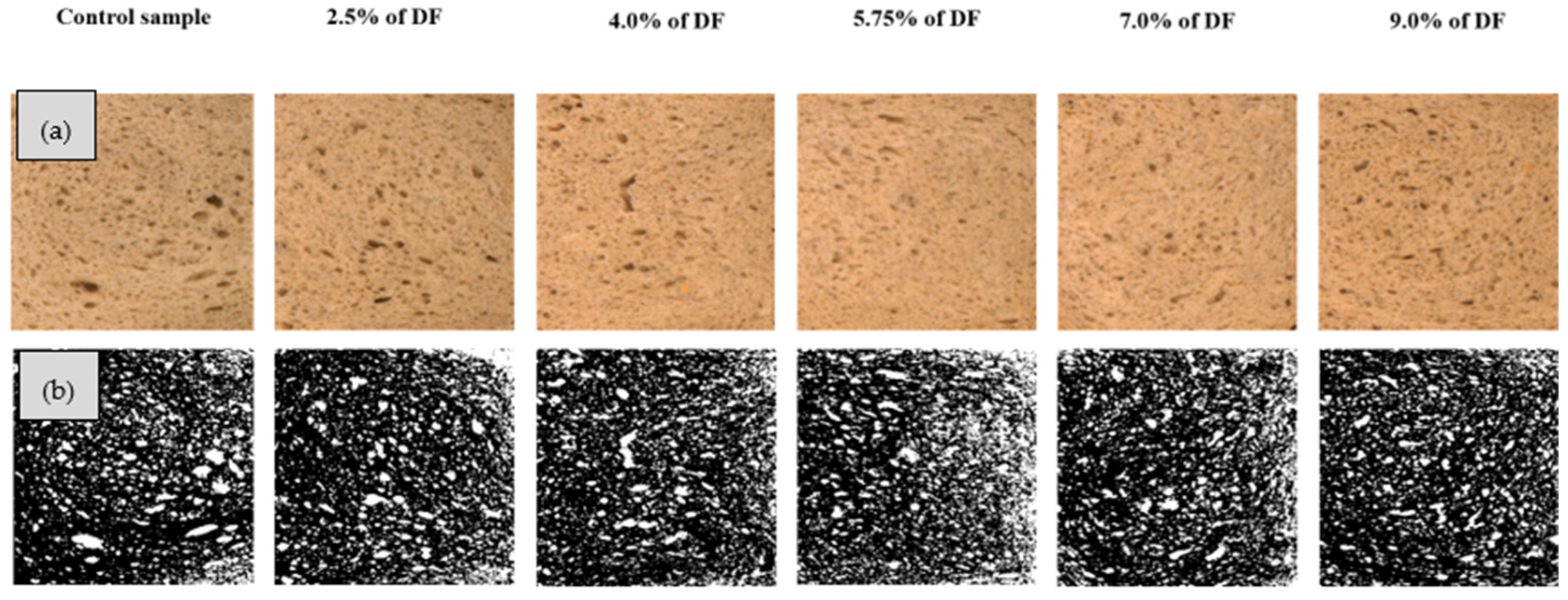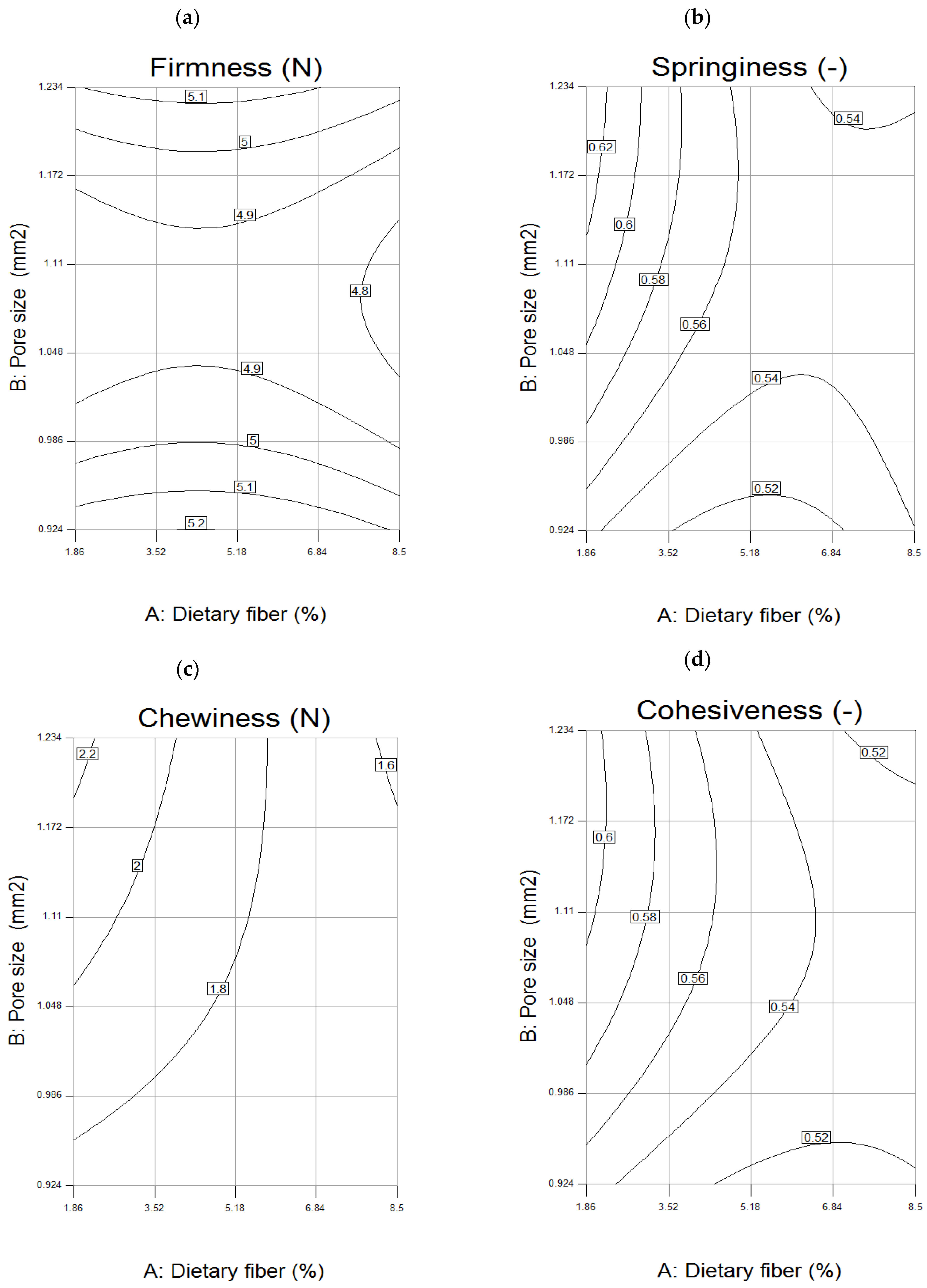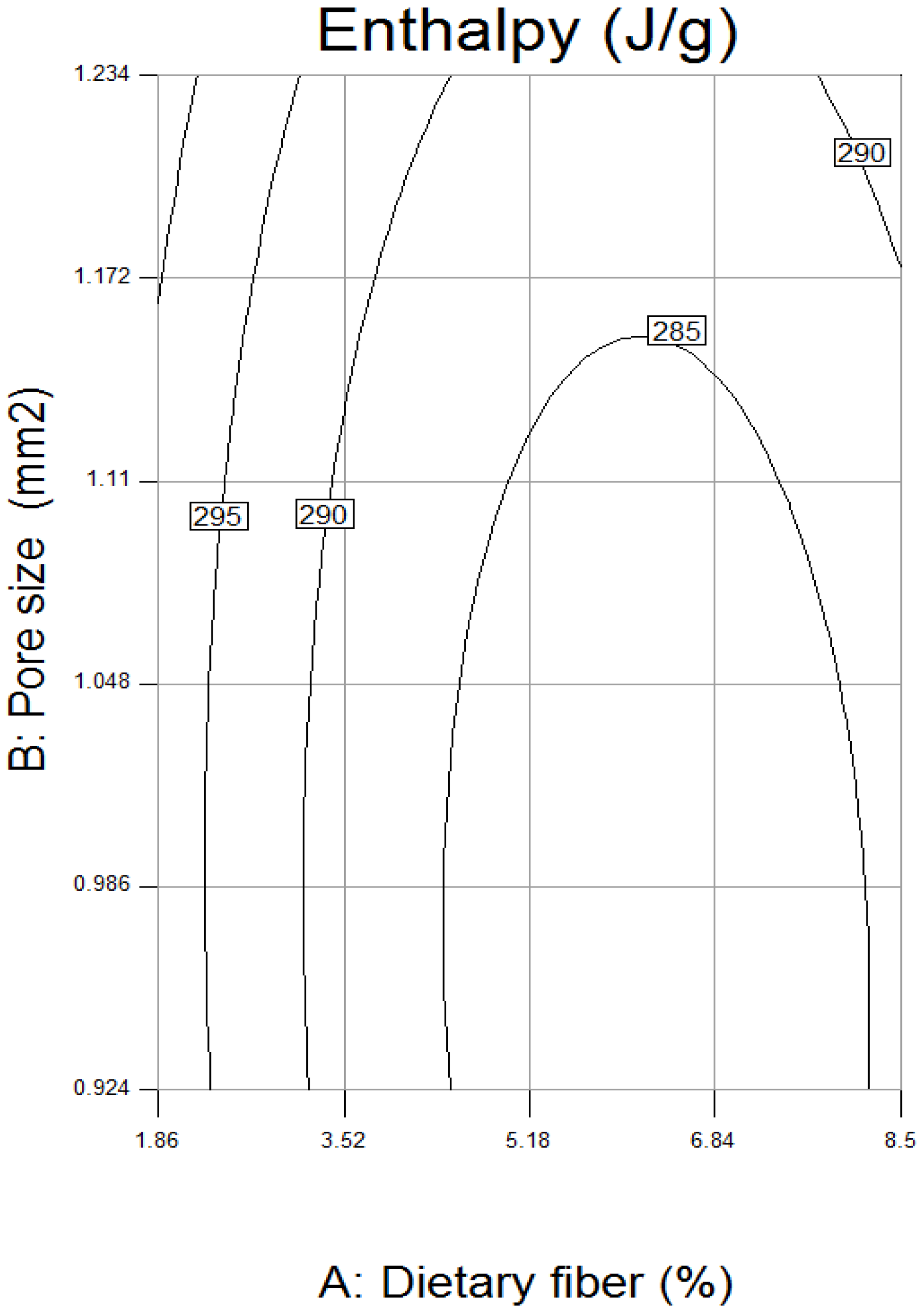Modeling of Texture and Starch Retrogradation of High-in-Fiber Bread Using Response Surface Methodology
Abstract
:1. Introduction
2. Materials and Methods
2.1. Raw Material and Preparation
2.2. Porosity Measurements—Digital Imaging Analysis
2.3. Texture Measurements
2.4. DSC Measurements
2.5. TDF Content Determination
2.6. Consumer Acceptance
2.7. Design of Experiment
2.8. Statistics
3. Results
3.1. Effects of DF on Porosity
3.2. Model for Firmness
3.3. Model for Springiness
3.4. Model for Chewiness
3.5. Model for Cohesiveness
3.6. Model for Enthalpy
3.7. Verification of the Models
3.8. Consumer Acceptance of Measured Samples
4. Conclusions
Author Contributions
Funding
Institutional Review Board Statement
Informed Consent Statement
Data Availability Statement
Conflicts of Interest
References
- Elía, M. A procedure for sensory evaluation of bread: Protocol developed by a trained panel. J. Sens. Stud. 2011, 26, 269–277. [Google Scholar] [CrossRef]
- Dall’Asta, C.; Cirlini, M.; Morini, E.; Rinaldi, M.; Ganino, T.; Chiavaro, E. Effect of chestnut flour supplementation on physico-chemical properties and volatiles in bread making. LWT—Food Sci. Technol. 2013, 53, 233–239. [Google Scholar] [CrossRef]
- Cabello-Olmo, M.; Krishnan, P.G.; Araña, M.; Oneca, M.; Díaz, J.V.; Barajas, M.; Rovai, M. Development, Analysis, and Sensory Evaluation of Improved Bread Fortified with a Plant-Based Fermented Food Product. Foods 2023, 12, 2817. [Google Scholar] [CrossRef] [PubMed]
- Sabanis, D.; Lebesi, D.; Tzia, C. Effect of dietary fibre enrichment on selected properties of gluten-free bread. LWT—Food Sci. Technol. 2009, 42, 1380–1389. [Google Scholar] [CrossRef]
- Compaore-Sereme, D.; Hama-Ba, F.; Tapsoba, F.W.; Manner, H.; Maina, N.H.; Dicko, M.H.; Sawadogo-Lingania, H. Production and sensory evaluation of composite breads based on wheat and whole millet or sorghum in the presence of Weissella confusa A16 exopolysaccharides. Heliyon 2023, 9, e13837. [Google Scholar] [CrossRef]
- Martin, C.; Chiron, H.; Issanchou, S. Impact of dietary fiber enrichment on the sensory characteristics and acceptance of french baguettes. J. Food Qual. 2013, 3, 324–333. [Google Scholar] [CrossRef]
- Barber, T.M.; Kabisch, S.; Pfeiffer, A.F.H.; Weickert, M.O. The Health Benefits of Dietary Fibre. Nutrients 2020, 12, 3209. [Google Scholar] [CrossRef]
- Tiwari, U.; Cummins, E. Meta-analysis of the effect of β-glucan intake on blood cholesterol and glucose levels. Nutrients 2011, 27, 1008–1016. [Google Scholar] [CrossRef]
- Xu, J.; Li, Y.; Zhao, Y.; Wang, D.; Wang, W. Influence of antioxidant dietary fiber on dough properties and bread qualities: A review. J. Funct. Foods 2021, 80, 104434. [Google Scholar] [CrossRef]
- Ozen, A.E.; Pons, A.; Tur, J.A. Worldwide consumption of functional foods: A systematic review. Nutr. Rev. 2012, 70, 472–481. [Google Scholar] [CrossRef]
- Kurek, M.A.; Wyrwisz, J.; Karp, S.; Wierzbicka, A. Effect of modified atmosphere packaging on the quality of wheat bread fortified with soy flour and oat fibre. Food Meas. 2019, 13, 1864–1872. [Google Scholar] [CrossRef]
- Lin, S. Chapter Two—Dietary fiber in bakery products: Source, processing, and function. In Advances in Food and Nutrition Research; Zhou, W., Gao, J., Eds.; Elsevier: Amsterdam, The Netherlands, 2022; Volume 99, pp. 37–100. [Google Scholar] [CrossRef]
- Ishida, P.M.G.; Steel, C.J. Physicochemical and sensory characteristics of pan bread samples available in the Brazilian market. Food Sci. Technol. Camp. 2014, 34, 746–754. [Google Scholar] [CrossRef]
- Hager, A.S.; Ryan, L.A.M.; Schwab, C.; Gänzle, M.G.; O’Doherty, J.V.; Arendt, E.K. Influence of the soluble fibres inulin and oat β-glucan on quality of dough and bread. Eur. Food Res. Technol. 2011, 232, 405–413. [Google Scholar] [CrossRef]
- Sivam, A.S.; Sun-Waterhouse, D.; Waterhouse, G.I.N.; Quek, S.; Perera, C.O. Physicochemical properties of bread dough and finished bread with added pectin fiber and phenolic antioxidants. J. Food Sci. 2011, 76, 97–107. [Google Scholar] [CrossRef] [PubMed]
- Ampatzoglou, A.; Atwal, K.K.; Maidens, C.M.; Williams, C.L.; Ross, A.B.; Thielecke, F.; Yaqoob, P. Increased whole grain consumption does not affect blood biochemistry, body composition, or gut microbiology in healthy, low-habitual whole grain consumers. J. Nutr. 2015, 145, 215–221. [Google Scholar] [CrossRef]
- Choi, H.; Kim, S.W. Characterization of β-Glucans from Cereal and Microbial Sources and Their Roles in Feeds for Intestinal Health and Growth of Nursery Pigs. Animals 2023, 13, 2236. [Google Scholar] [CrossRef]
- Chen, J.; Huang, X.F. The effects of diets enriched in beta-glucans on blood lipoprotein concentrations. J. Clin. Lipidol. 2009, 3, 154–158. [Google Scholar] [CrossRef]
- Panahi, S.; Ezatagha, A.; Jovanovski, E.; Jenkins, A.; Temelli, F.; Vasanthan, T.; Vuksan, V. Glycemic effect of oat and barley beta-glucan when incorporated into a snack bar: A dose escalation study. J. Am. Coll. Nut. 2014, 33, 442–449. [Google Scholar] [CrossRef]
- Gavurníková, S.; Havrlentová, M.; Kraic, J. Effects of starchy and β-glucan additives on flour, dough, and bread parameters. Acta Alim. 2014, 43, 210–217. [Google Scholar] [CrossRef]
- Astiz, V.; Guardianelli, L.M.; Salinas, M.V.; Brites, C.; Puppo, M.C. High β-Glucans Oats for Healthy Wheat Breads: Physicochemical Properties of Dough and Breads. Foods 2023, 12, 170. [Google Scholar] [CrossRef]
- Datta, A.K.; Sahin, S.; Sumnu, G.; Keskin, S.E. Porous media characterization of breads baked using novel heating modes. J. Food Eng. 2007, 79, 106–116. [Google Scholar] [CrossRef]
- Yolmeh, M.; Jafari, S.M. Applications of Response Surface Methodology in the Food Industry Processes. Food Bioprocess Technol. 2017, 10, 413–433. [Google Scholar] [CrossRef]
- Tambo Tene, S.; Kohole Foffe, H.A.; Adebo, O.A.; Tantoh Ndinteh, D.; Tsopbeng Tsopzong, A.B.; Kenfack, J.O.; Kengne Kamdem, M.H.; Klang, J.M.; Womeni, H.M. Application of the response surface methodology (RSM) in the optimization of the fluidizing and sweetening capacities of sprouted flours of two maize varieties (Atp-Y and Coca-sr). Cogent Food Agric. 2023, 9, 2279724. [Google Scholar] [CrossRef]
- Rashidi, A.; Hadinezhad, M.; Rajabzadeh, N.; Yarmand, M.-S.; Nemati, S. Frozen baguette bread dough II. Textural and sensory characteristics of baked product. J. Cereal Sci. 2016, 70, 9–15. [Google Scholar] [CrossRef]
- Kurek, M.A.; Wyrwisz, J.; Wierzbicka, A. Effect of β-glucan particle size on the properties of fortified wheat rolls. CyTA—J. Food 2016, 1, 124–130. [Google Scholar] [CrossRef]
- Kurek, M.A.; Wyrwisz, J.; Wierzbicka, A. Optimization of beta-glucan and water content in fortified wheat bread using Response Surface Methodology according to staling kinetics. LWT—Food Sci. Technol. 2017, 5, 352–357. [Google Scholar] [CrossRef]
- Sullivan, P.; O’flaherty, J.; Brunton, N.; Arendt, E.; Gallagher, E. Fundamental rheological and textural properties of doughs and breads produced from milled pearled barley flour. Eur. Food Res. Technol. 2010, 231, 441–453. [Google Scholar] [CrossRef]
- Kurek, M.A.; Wyrwisz, J.; Piwińska, M.; Wierzbicka, A. Influence of the wheat flour extraction degree in the quality of bread made with high proportions of β-glucan. Food Sci. Technol. 2015, 2, 273–278. [Google Scholar] [CrossRef]
- Wyrwisz, J.; Karp, S.; Kurek, M.A.; Moczkowska-Wyrwisz, M. Evaluation of Modified Atmosphere Packaging in Combination with Active Packaging to Increase Shelf Life of High-in Beta-Glucan Gluten Free Cake. Foods 2022, 11, 872. [Google Scholar] [CrossRef]
- Moczkowska-Wyrwisz, M.; Jastrzębska, D.; Wyrwisz, J. Application of New Sources of Bioactive Substances (Perilla frutescens L. and Tagetes erecta L.) in the Chosen Cookies Production. Int. J. Environ. Res. Public Health 2022, 19, 11504. [Google Scholar] [CrossRef]
- García-Gómez, B.; Fernández-Canto, N.; Vázquez-Odériz, M.L.; Quiroga-García, M.; Muñoz-Ferreiro, N.; Romero-Rodríguez, M.Á. Sensory descriptive analysis and hedonic consumer test for Galician type breads. Food Control 2022, 134, 108765. [Google Scholar] [CrossRef]
- Polska Norma P 4121: 1998; Anal. Sensoryczna–Metodologia–Ocena Produktów Zywn. Przy Uzyciu Metod Skalowania. PKN: Warsaw, Poland, 1998.
- Norma P PN–ISO 6658; Analiza Sensoryczna. Metodol. Wytyczne Ogólne. PKN: Warsaw, Poland, 1998.
- Rosell, C.M.; Santos, E.; Collar, C. Physico-chemical properties of commercial fibres from different sources: A comparative approach. Food Res. Int. 2009, 42, 176–184. [Google Scholar] [CrossRef]
- O’shea, N.; Rößle, C.; Arendt, E.; Gallagher, E. Modelling the effects of orange pomace using response surface design for gluten-free bread baking. Food Chem. 2015, 166, 223–230. [Google Scholar] [CrossRef] [PubMed]
- Xu, F.; Gao, Q.; Ma, Y.; Guo, X.; Wang, M.I.N. Comparison of tartary buckwheat flour and sprouts steamed bread in quality and antioxidant property. J. Food Qual. 2014, 37, 318–328. [Google Scholar] [CrossRef]
- Collar, C.; Angioloni, A. Nutritional and functional performance of high β-glucan barley flours in breadmaking: Mixed breads versus wheat breads. Eur. Food Res. Technol. 2014, 238, 459–469. [Google Scholar] [CrossRef]
- Ortiz de Erive, M.; He, F.; Wang, T.; Chen, G. Development of β-glucan enriched wheat bread using soluble oat fiber. J. Cereal Sci. 2020, 95, 103051. [Google Scholar] [CrossRef]
- Feili, R.; Zzaman, W.; Nadiah, W.; Abdullah, W.; Yang, T.A. Physical and sensory analysis of high fiber bread incorporated with jackfruit rind flour. Food Sci. Technol. 2013, 1, 30–36. [Google Scholar] [CrossRef]
- Londono, D.M.; Gilissen, L.J.; Visser, R.G.; Smulders, M.J.; Hamer, R.J. Understanding the role of oat β-glucan in oat-based dough systems. J. Cereal Sci. 2015, 62, 1–7. [Google Scholar] [CrossRef]
- Rizzello, C.G.; Calasso, M.; Campanella, D.; De Angelis, M.; Gobbetti, M. Use of sourdough fermentation and mixture of wheat, chickpea, lentil and bean flours for enhancing the nutritional, texture and sensory characteristics of white bread. Int. J. Food Microbiol. 2014, 180, 78–87. [Google Scholar] [CrossRef]
- Schleibinger, M.; Meyer, A.; Afsar, N.; Nagy, A.; Dieker, V.; Schmitt, J.J. Impact of Dietary Fibers on Moisture and Crumb Firmness of Brown Bread. Adv. J. Food Sci. Technol. 2013, 5, 1281–1284. [Google Scholar] [CrossRef]
- Besbes, E.; Jury, V.; Monteau, J.-Y.; Le Bail, A. Effect of baking conditions and storage with crust on the moisture profile, local textural properties and staling kinetics of pan bread. LWT—Food Sci. Technol. 2014, 58, 658–666. [Google Scholar] [CrossRef]
- Smith, I.N.; Yu, J. Nutritional and sensory quality of bread containing different quantities of grape pomace from different grape cultivars. EC Nutr. 2015, 2, 291–301. [Google Scholar]
- Šporin, M.; Avbelj, M.; Kovač, B.; Možina, S.S. Quality characteristics of wheat flour dough and bread containing grape pomace flour. Food Sci. Technol. Int. 2018, 24, 251–263. [Google Scholar] [CrossRef] [PubMed]
- Salehi, F.M.; Shahedi, M. Effects of oat flour on dough rheology, texture and organoleptic properties of taftoon bread. Food Sci. Technol. Int. 2007, 9, 227–234. [Google Scholar]




| Firmness | Springiness | Chewiness | Cohesiveness | Enthalpy | |
|---|---|---|---|---|---|
| Intercept | 4.87 | 0.55 | 1.80 | 0.55 | 284.06 |
| A—DF | −0.034 | −0.026 * | −0.19 ** | −0.032 ** | −5.51 |
| B—pore size | −0.031 | 0.021 | 0.10 ** | 0.013 | 2.63 ** |
| C—porosity | −0.19 | 0.035 ** | 0.12 ** | 0.039 | 6.52 |
| D—pore density | 0.074 | −0.014 | −0.058 | −0.020 | −2.88 |
| AB | 0.024 | −0.023 | −0.16 ** | −0.016 | 0.59 |
| AC | −0.55 ** | 0.017 | 0.033 | 0.023 | −6.38 |
| AD | −0.098 | −0.083 | −0.067 | −0.097 | −2.64 *** |
| BC | 0.11 | 0.021 | 0.062 | 0.013 | 8.46 |
| BD | 0.19 | 0.0487 | 0.031 *** | 0.068 | −1.48 |
| CD | −0.043 | 0.027 | 0.066 | 0.017 | 5.65 |
| A2 | −0.071 *** | 0.031 * | 0.043 | 0.017 * | 8.73 ** |
| B2 | 0.30 * | −0.017 | −0.033 | −0.021 | 1.86 |
| C2 | 0.18 | −0.023 * | −0.075 | −0.024 ** | −1.72 |
| D2 | 0.21 | 0.0493 | 0.044 | 0.00141 | 4.90 |
| Lack of fit | 0.8294 | 0.8583 | 0.9373 | 0.9037 | 0.6681 |
| R2 | 0.807 | 0.791 | 0.865 | 0.688 | 0.825 |
| DF (%) | Pore Size (mm2) | Porosity (%) | Pore Density (per cm2) | Firmness (N) | Springiness (−) | Chewiness (N) | Cohesiveness (−) | Enthalpy (J/g) | |
|---|---|---|---|---|---|---|---|---|---|
| 2.22 | 1.04 | 25.32 | 4.28 | C * | 4.81 | 0.59 | 1.93 | 0.59 | 295.05 |
| M ** | 4.71 | 0.52 | 1.9 | 0.54 | 287.15 | ||||
| 6.80 | 1.12 | 27.40 | 4.17 | C | 4.72 | 0.57 | 1.82 | 0.57 | 288.43 |
| M | 4.41 | 0.52 | 1.74 | 0.69 | 278.14 |
Disclaimer/Publisher’s Note: The statements, opinions and data contained in all publications are solely those of the individual author(s) and contributor(s) and not of MDPI and/or the editor(s). MDPI and/or the editor(s) disclaim responsibility for any injury to people or property resulting from any ideas, methods, instructions or products referred to in the content. |
© 2024 by the authors. Licensee MDPI, Basel, Switzerland. This article is an open access article distributed under the terms and conditions of the Creative Commons Attribution (CC BY) license (https://creativecommons.org/licenses/by/4.0/).
Share and Cite
Wyrwisz, J.; Moczkowska-Wyrwisz, M.; Kurek, M.A. Modeling of Texture and Starch Retrogradation of High-in-Fiber Bread Using Response Surface Methodology. Appl. Sci. 2024, 14, 11603. https://doi.org/10.3390/app142411603
Wyrwisz J, Moczkowska-Wyrwisz M, Kurek MA. Modeling of Texture and Starch Retrogradation of High-in-Fiber Bread Using Response Surface Methodology. Applied Sciences. 2024; 14(24):11603. https://doi.org/10.3390/app142411603
Chicago/Turabian StyleWyrwisz, Jarosław, Małgorzata Moczkowska-Wyrwisz, and Marcin A. Kurek. 2024. "Modeling of Texture and Starch Retrogradation of High-in-Fiber Bread Using Response Surface Methodology" Applied Sciences 14, no. 24: 11603. https://doi.org/10.3390/app142411603
APA StyleWyrwisz, J., Moczkowska-Wyrwisz, M., & Kurek, M. A. (2024). Modeling of Texture and Starch Retrogradation of High-in-Fiber Bread Using Response Surface Methodology. Applied Sciences, 14(24), 11603. https://doi.org/10.3390/app142411603









